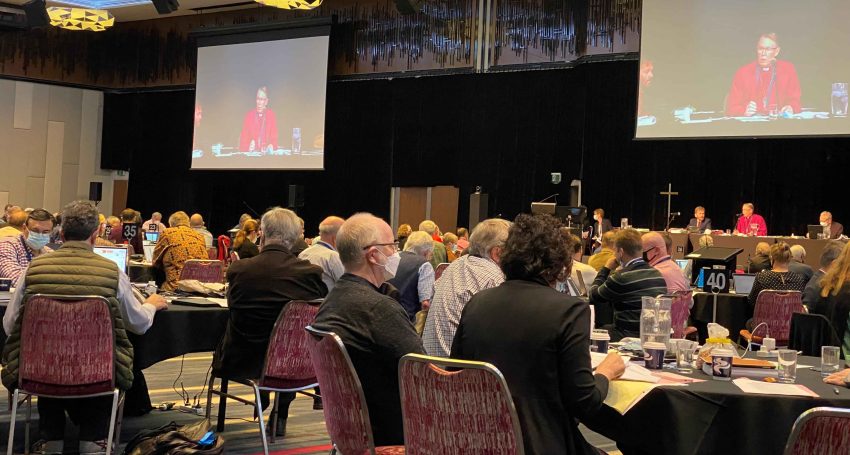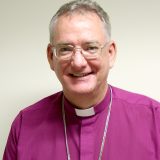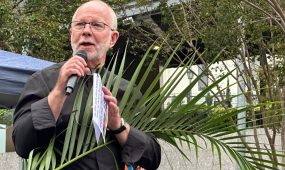The General Synod: outcomes and personal reflections
Reflections
“Thank you for your prayers for the recently concluded session of the General Synod, which was held on the Gold Coast between 8 and 13 May after being postponed twice due to COVID-19. I write to inform you of some important outcomes and to offer some personal reflections,” says Archbishop Phillip Aspinall

Dear Brothers and Sisters,
Thank you for your prayers for the recently concluded session of the General Synod, which was held on the Gold Coast between 8 and 13 May after being postponed twice due to COVID-19. I write to inform you of some important outcomes and to offer some personal reflections.
You have probably seen media coverage and may have read others’ perspectives. I know many people have felt pain and distress at some of the outcomes and reporting, just as many felt anxious and uncertain as the General Synod approached.
Participation Canon
Due to COVID-19, necessary special arrangements were made to enable those in isolation or who were unable to attend because of other government requirements to participate online. A ‘Participation Canon’ was passed at the beginning of the Synod and about 10 people took advantage of those arrangements. It worked reasonably well and a number of online attendees contributed to debates in the Synod hall.
The Synod decided to develop arrangements to enable greater participation in future General Synods, online and in-person, by people facing particular obstacles, including disability, disease or illness, other medical conditions or injuries. It seems that hybrid arrangements will continue to be made and greater attention given to physical accessibility in venues.
Child safety
A number of different child safety compliance, audit and reporting regulations are emerging in Australian states and territories in response to recommendations of the Royal Commission into Institutional Responses to Child Sex Abuse and various state-level inquiries. In addition, the Anglican Church has adopted a national framework of requirements, as recommended by the Royal Commission.
This multiplying of compliance, audit and reporting regimes has led to the General Synod initiating a process to review, streamline and, as far as possible, avoid duplication in regimes. This may lead to amendments to Church legislation down the track.
Climate change
The General Synod passed two comprehensive resolutions on climate change – one addressed to the Church and another addressed to Australian governments.
The first challenges the Church to recognise the theological imperatives to act and the fundamental issues of justice involved. It proposes clear targets concerning carbon emissions and invites specific actions.
The call to Australian governments urges them to recognise that the greatest impacts of climate change are particularly affecting people on small island communities in the Pacific and our own Aboriginal and Torres Strait Islander communities.
Social issues
Among other social issues addressed by the Synod were the difficulties faced by those relying solely on JobSeeker payments, which are below the poverty line; adequate funding of aged and disability care and the NDIS; federal, state and territory-based gambling reform; suicide among Australian Defence Force veterans; Defence Force chaplaincy; and, balancing anti-discrimination protections and religious freedoms.
Ecumenical guests
Several ecumenical guests attended the General Synod. Next year in Rome, the Roman Catholic Church is convening an international Synod on synodality. In preparation Roman Catholic observers are attending the synods of sister churches to observe how they go about things and to glean learnings. Three Roman Catholic observers attended parts of our General Synod.
A representative from the Lutheran Church of Australia also attended and addressed the Synod as it considered and finally adopted ‘Perspectives on Mission’, a third addendum to the Common Ground agreement first adopted in 2004.
National Anglican Family Violence Project
At diocesan level we have already considered some of the outcomes of the Anglican Church’s family violence research projects. This was the first time the General Synod had opportunity to do so.
The General Synod recognised, as we did at last year’s Diocesan Synod, the salutary outcomes of that research: the Anglican Church has allowed an environment in which family violence has gone largely unaddressed and the prevalence of intimate partner violence among Anglicans is as high, if not higher, than in the wider community.
Advertisement
We have important and urgent work to do in preventing such violence and in developing pastoral responses to it. The General Synod adopted the Ten Commitments for Prevention and Response to Domestic and Family Violence in the Anglican Church of Australia and called on diocesan synods to do so as well if they haven’t already. A ‘Families and Culture Commission’ was created to follow through and coordinate this work.
A further resolution called on the new Families and Culture Commission to collaborate with the National Aboriginal and Torres Strait Islander Anglican Council (NATSIAC) in implementing two five-year Federal Government plans to tackle family violence in Aboriginal and Torres Strait Islander communities.
Viability of regional dioceses
General Synod acknowledged the financial strains under which regional, rural and isolated dioceses are operating. This is partly due to the combined impacts of sexual abuse redress payments, sharply increasing insurance premiums and the considerable costs of implementing mandated compliance, audit and reporting processes, which are necessary to protect children. A resolution urges metropolitan dioceses to support to a greater extent all dioceses in their province.
Marriage and blessings of two people of the same sex
Many anticipated the General Synod with some fear and trembling because of heightened tensions over marriage between two people of the same sex in both Church and civil contexts in recent years.
In 2017 the Australian Marriage Act 1961 was amended to define “marriage” as “the union of 2 people to the exclusion of all others, voluntarily entered into for life”. Previously “marriage” was defined as “‘the union of a man and a woman to the exclusion of all others, voluntarily entered into for life”. This change made lawful in Australia the marriage of two persons of the same sex. It did not, however, mean such marriages could be solemnised in the Anglican Church because in our authorised marriage services marriage continues to be understood to be between one man and one woman.
Advertisement
Following the 2017 amendment to the Marriage Act, in 2019 the Synod of Wangaratta Diocese passed a regulation concerning liturgical blessing for two persons married in accordance with the Marriage Act 1961. The regulation provided that no minister could be compelled to conduct such a service if to do so would offend the minister’s conscience, but where a minister consented to do so the regulation required the use of a specified form of service and no other. Given the amended Marriage Act, this applied both to marriages of a man and a woman and also to marriages between two persons of the same sex.
In the wake of this action in Wangaratta the Primate referred two questions to the Appellate Tribunal asking, first, whether the regulation made by Wangaratta’s Synod was consistent with the Fundamental Declarations and Ruling Principles in our Constitution and, secondly, whether the regulation was validly made under the Canon Concerning Services 1992.
In a closely argued and lengthy determination published in November 2020, by a majority of 5 to 1, the Appellate Tribunal ruled that “Wangaratta Diocese’s proposed service for the blessing of persons married in accordance with the Marriage Act does not entail the solemnisation of marriage, is authorised by the Canon Concerning Services 1992; and is not inconsistent with the Fundamental Declarations and Ruling Principles of the Constitution of the Church.” In other words, it was lawful in the Anglican Church.
This determination evoked strong reactions in various parts of the Church – some very much in favour of proceeding with such blessings and some strenuously against. In the face of deep conflict, the Primate urged restraint in acting on the Tribunal’s decision until the Church had an opportunity to consider in General Synod questions raised by the Tribunal’s ruling. As we know the meeting of the General Synod was postponed twice, the delay adding to growing tensions and anxieties. The Primate’s request was, however, largely, if not entirely, respected.
When the General Synod finally met earlier this month, the Synod was asked to endorse two statements prepared by the Standing Committee of Sydney Diocese.
Statement 1 was titled “Marriage as the union of a man and a woman”. After a lengthy, passionate and respectful debate, a call for a vote by Houses saw the statement agreed to by a substantial majority in the House of Laity (63-47) and the House of Clergy (70-39) and narrowly defeated in the House of Bishops (10-12). Requiring a majority in favour in all three Houses to pass, the statement was defeated.
Some expressed deep consternation, even incredulity and alarm, over this outcome. When the statement was lost, immediately the mover, the Archbishop of Sydney, sought leave to make a “personal statement” to the General Synod. He described the situation of the Anglican Church of Australia as “perilous”. The Synod agreed to adjourn forthwith for an extended lunchbreak. Feelings were running high.
Some members of the General Synod inferred, wrongly in my view, that the majority of the House of Bishops who voted against making the statement did so because they were unwilling to uphold the Church’s traditional teaching on marriage and even that they had abandoned this teaching. In my view such an inference is incorrect and unsustainable, though it has been repeatedly asserted in media reports and other communications since the Synod.
There could be many reasons why a majority of members of the House of Bishops voted against the statement. I think it likely that some Bishops objected to the final clause in the proposed statement that, “Any rite that purports to bless a same sex marriage is not in accordance with the teaching of Christ and the faith, ritual, ceremonial and/or discipline of this Church.” That assertion appears to be tantamount to contradicting the authoritative determination of the Appellate Tribunal, and even attempting to overturn it. It is likely, in my view, that a significant number of Bishops would have been deeply troubled by the prospect of perceptions of disrespecting the Constitutional authority of the Appellate Tribunal in this way.
Wider concerns were likely to have been in play, too. I expect that some Bishops were dissatisfied, even resentful, at the process by which the proposed statement came to the General Synod. As I understand it, the Sydney Standing Committee itself drafted the proposed statement and presented it to the General Synod, more or less as a fait accompli, take it or leave it. I’m sure some Bishops felt alienated by and even angry about this process. It’s not the way the national Church has been accustomed to working, in my experience.
Thirdly, Bishops might have declined to make the statement because a number of reasonable, fact-based amendments moved in attempts to provide a fuller, more nuanced account of marriage as it currently stands in the Church were rejected by proponents of the statement. This also could have led some Bishops to reject the statement overall.
Finally, there were concerns that making such a statement at this time would be singularly unhelpful to the Church’s mission and pastoral endeavours in Australian society.
The General Synod later considered a motion from the opposite perspective, which, among other things, proposed firm support for civil same sex marriage sought to declare it to be a moral good, an enrichment of the Christian understanding of marriage, and consistent with the scriptures, the creeds and Anglican tradition.
This was quite remarkable and an initiative that would have been unthinkable even 20 years ago. The proponents set out comprehensively what they saw as the biblical, theological and spiritual grounds for such an endorsement. Again, the debate was respectful and thoughtful. The motion was defeated 95 to 145. However, the fact that 40 per cent of the General Synod voted in favour shows how much and how quickly the ground has shifted, both in wider society and in the Church
At Diocesan Synod in late June, I plan to share at greater length the broader context in Australian society and its implications for our mission and pastoral ministry.
Unfortunately, to my mind, the idea of “comprehensive” Anglicanism that we have embraced and are seeking to foster in this diocese failed to prevail at the recent General Synod. Several indicators suggest to me that nurturing our vision of comprehensive Anglicanism has never been more important nor more at risk.
Clearly the recent General Synod did not resolve for us once and for all contentious issues around sexuality and marriage. Notwithstanding that many hoped it would, this was an unrealistic expectation.
One thing is certain. The Australian landscape has changed. marriage between two people of the same sex is a reality in our society, provided for by Australian law. So the Church has no choice but to consider how it will respond to this altered context. Again I will explore this further at our coming Diocesan Synod on 24-26 June.
The resolutions and decisions of General Synod may be read online.
This comes with my thanks for your prayers and the assurance of mine for you,
Yours in Christ,
The Most Reverend Dr Phillip Aspinall AC
Archbishop of Brisbane






